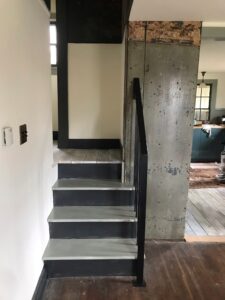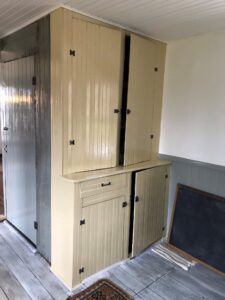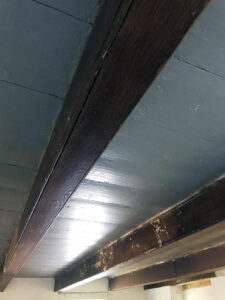How do you rehabilitate an old house? That’s a big topic. Every house is different; each has its own rules and, shall we say, quirks? In response to careful attention and patience, old houses reveal what they need. The real question is, where do you even start?
The best beginner’s references for all things historic rehabilitation are the National Park Service’s Preservation Briefs. Here’s a good one to get your wheels turning: Preservation Brief 18: Rehabilitating Interiors in Historic Buildings Identifying and Preserving Character-defining Elements by H. Ward Jandl.
While the Brief focuses on interior elements, the same approach can be applied to the building as a whole. Above are some examples of “character-defining features” we identified in a ca-1800 Hudson Valley home that needed a whole lot of TLC (after many years of neglect, it had finally been abandoned by its previous owners). Some elements declared themselves right away. Architectural historians took one look at the house’s overall shape, peeked in the attic to find old hewn timbers assembled in “H bents”, and named the structure a fine specimen of “New World Dutch Vernacular”, eligible for the National Register of Historic Places. Other interesting features included the cased beams with beaded detail (probably dating from the earliest construction) and the beadboard built-in hutch in the kitchen (like the “gingerbread-y” front porch, added later in the 19th century). Still more gems awaited discovery once we peeled back some layers – for example, the wideboard wall paneling that had been covered in 20th-century drywall.
An important point is that features don’t have to be original to be “character defining” nor do they need to be one of a kind, the work of a great architect, the vestiges of a prominent person, or the site of a significant historical event. The Brief explains, “The interior of a plain, simple detailed worker’s house of the 19th century [such as the Hudson Valley example above] may be as important historically as a richly ornamented, high-style townhouse of the same period.” The same goes for the features that define its character. They just need to tell a part of the story.
So, then, you may well ask, don’t *all* features tell a story, even those we find ugly/obsolete/beyond repair and would just as soon consign to the dust heap? How do you decide which features are worth preserving?
Historic rehabilitation (in contrast to conservation) is less a science than an art. It takes some knowledge, experience and skill. There’s more to it than personal taste, but there’s also a good deal of latitude for informed judgment. The basis for making sound decisions about your old house is always careful observation, research (reading the Preservation Briefs series is a great place for an old house owner to start) and, when necessary, calling on professional advice.
Key takeaway from Brief 18: “Before determining what uses might be appropriate and before drawing up plans [for a rehabilitation project], a thorough professional assessment should be undertaken to identify those tangible architectural components that, prior to rehabilitation, convey the building’s sense of time and place-that is, its ‘historic character.'”
Of course, if you’re ready to hire a pro, I’m here for you. In the meantime, as a first step, try this “Rehabilitation Checklist for People Who Love Old Houses” to hone your observation skills. Savor each detail!


